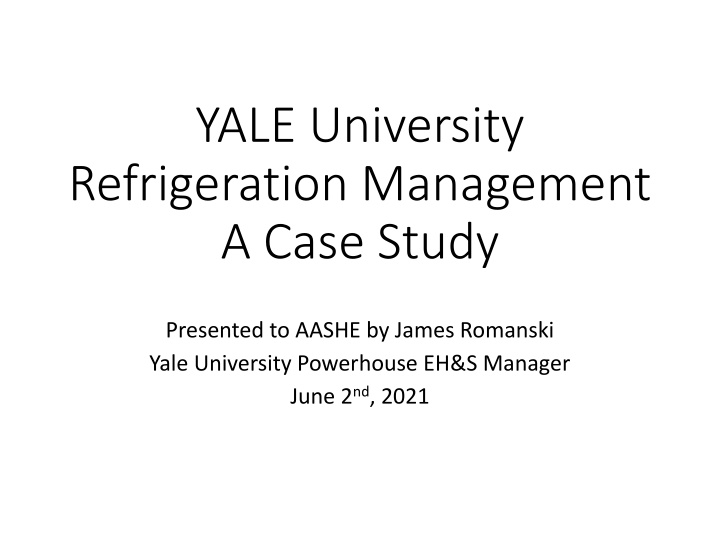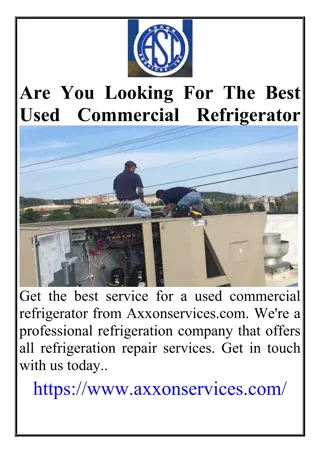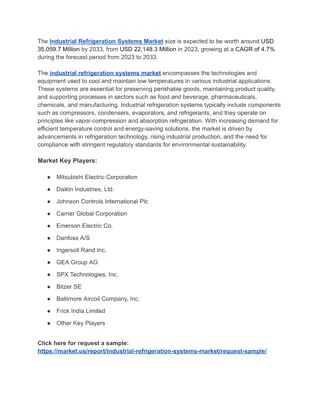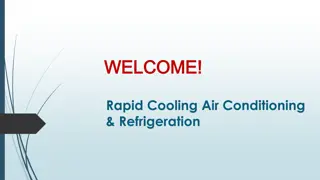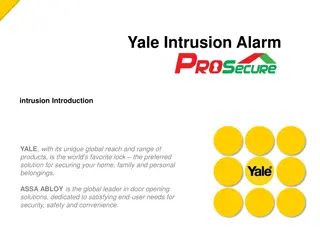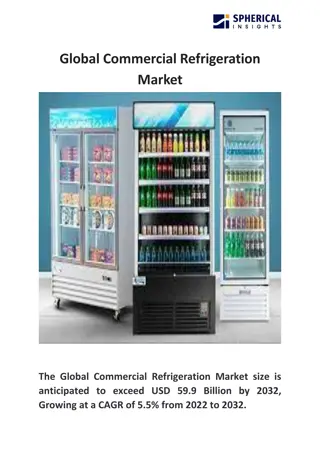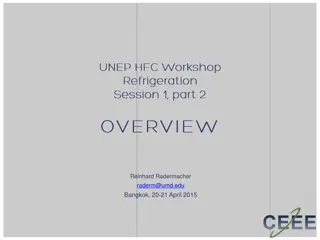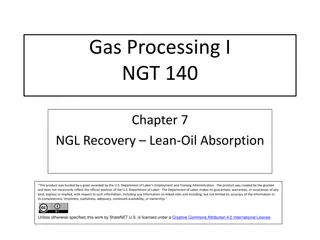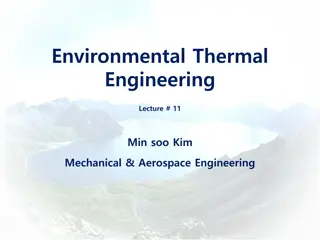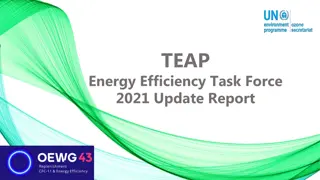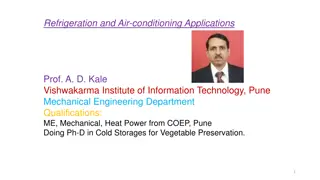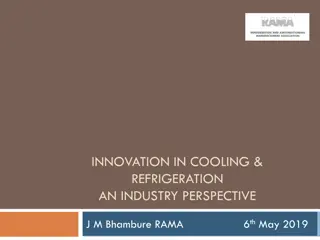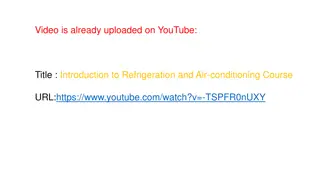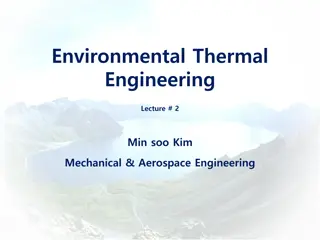Yale University Refrigeration Management Case Study
This case study explores the management of refrigeration equipment at Yale University, emphasizing the importance of leak detection, technician identification, and compliance management. It covers residential, commercial, and industrial refrigeration, as well as the development of inventory and initial program implementation. The focus is on reducing refrigerant leaks to mitigate environmental impact and ensure efficient operation.
Download Presentation

Please find below an Image/Link to download the presentation.
The content on the website is provided AS IS for your information and personal use only. It may not be sold, licensed, or shared on other websites without obtaining consent from the author.If you encounter any issues during the download, it is possible that the publisher has removed the file from their server.
You are allowed to download the files provided on this website for personal or commercial use, subject to the condition that they are used lawfully. All files are the property of their respective owners.
The content on the website is provided AS IS for your information and personal use only. It may not be sold, licensed, or shared on other websites without obtaining consent from the author.
E N D
Presentation Transcript
YALE University Refrigeration Management A Case Study Presented to AASHE by James Romanski Yale University Powerhouse EH&S Manager June 2nd, 2021
Managing Refrigerant Leaks Refrigeration Equipment is not Designed to Emit Refrigerants High Pressures and Demanding Mechanical Duty and Outside Use can lead to Leaks Leaking Product vs Emitting Air Pollutants Combustion Equipment emits by product air pollutants Refrigerant is a Product Like gasoline evaporative losses at gas stations nobody wants to lose refrigerants Leaks = Losses
Refrigeration Equipment Residential
Refrigeration Equipment Commercial
Refrigeration Equipment Industrial
Leak Detection Dyes and Soap Bubbles
Initial Program ODS Class I and II Development of Inventory Identify Refrigeration Technicians Review Record Keeping Purchase Refrigerant Compliance Management Software
Development of Inventory Powerplants Large Industrial Size Chillers both electrically driven, and steam driven Large Facilities not Served by Powerplant Libraries Hospitals/Medical Centers Food Services
Identify Refrigeration Technicians Powerplants Use Equipment Manufacturer s Contractors Carrier York Trane Other On Campus Units Yale Certified Refrigeration Technicians
Review Record Keeping Powerplant Equipment Contractors Generally, very knowledgeable about EPA requirements Record Keeping adequate though not centralized Yale Refrigeration Technicians Mostly servicing <50 lbs charge units Record Keeping not required for these units We asked them to fill out appliance profiles for units as they service them even if <50 lbs charge
Purchased Refrigeration Compliance Software Refrigeration Compliance Software (RCM) For the longest time RCM was the only software package available Has been bought out by several software companies over the year Currently owned by Sphera along with the original developers and refrigeration experts Other software packages now available from other vendors
Using the Software Provided a template for information required Included service forms for technicians with information required by EPA to track leak rates We require technicians to use the forms for any service done on Class I and II units with >50 lbs charge any time refrigerant is added or removed. Can also be used to generate service requests Can also be used for refrigerant inventory management
Old Compliance Program Checklist Requirements: Maintain Copies of All Technician Certifications (Contractors maintain their own) Leak Repair Recordkeeping - Service Records for All Appliances with a full charge capacity of >50 pounds of Class I & II ODS including Refrigerant Additions Leak Tests & Dates of Initial & Follow-up Verification Tests (Only for Industrial units) Retrofit or Retirement Plans if any. Limited Leak Reporting (Only for leak rate calculation exemption) Proof of Certification by Purchaser. Records of Class I & II ODS Refrigerant Reclaimed. Certification of Persons Disposing of Appliances and Records of Disposal (Typically the Recycling Vendor). One Time Notification of Certified Reclaim Equipment Registrations
Expansion of Program due to Addition of HFC Refrigerants Expansion of Inventory New Requirements Identify Outside Contractor Technicians Hiring of Full Time Refrigerant Compliance Manager
Expansion of Inventory Powerplants Large Facilities not Served by Powerplant More Libraries Museums Hospital Walk in Coolers Rooftop Units
Yale University Refrigeration Units Inventory (Excel Spreadsheet) Active Units Inactive Units
New New Compliance Program Checklist Requirements: Maintain Copies of All Technician Certifications (Contractors maintain their own Leak Repair Record Keeping - Service Records for All Appliances with a full charge capacity of >50 lbs of ALL Refrigerants with very few exceptions. Lower Leak Rate Thresholds Refrigerant Additions Additional Details for Service Records Leak Rate Calculations and Methods Leak Tests & Dates of Initial & Follow-up Verification Tests. For ALL types of Units. Retrofit or Retirement Plans if any. Additional Details and Must be Reported to EPA Leak Inspections Required if Leak Rate Exceeded and Chronic Leakers Leak Reporting Expanded to ALL Appliances subject to leak repair provisions. Proof of Certification by Purchaser. Records of ALL Refrigerant Reclaimed. Certification of Persons Disposing of Appliances and Records of Disposal (Typically the Recycling Vendor). Recordkeeping for disposal of appliances with full charge > 5 lbs and < 50 lbs One Time Notification of Certified Reclaim Equipment Registrations (No Longer Required)
Purchasing Practices Plan for Phase out of R-22 Plan for Phase out of HFCs
What about that Class II Phase Out Schedule The phaseout schedule, the additional market forces, and The future cost of purchasing refrigerants.
U.S. Action to Meet the Montreal Protocol Phaseout Class II Schedule Implementation of HCFC Phaseout through Clean Air Act Regulations Percent Reduction in HCFC Consumption and Production from Baseline Year to Be Implemented Year to Be Implemented No production or import of HCFC-141b 2003 2004 35.0% No production or import of HCFC-142b and HCFC-22, except for use in equipment manufactured before January 1, 2010 2010 2010 75.0% No production or import of any other HCFCs, except as refrigerants in equipment manufactured before January 1, 2020 2015 2015 90.0% No production or import of HCFC-142b and HCFC-22 2020 2020 99.5% No production or import of any HCFCs 2030 2030 100.0%
Common HCFCs and Their Uses HCFC-22: (aka R-22) used as a refrigerant in several applications such as unitary air conditioners, cold storage, retail food refrigeration equipment, chillers, and industrial process refrigeration. Also historically used (in smaller quantities) as a blowing agent for certain foam applications and as a propellant in aerosols. HCFC-141b: used as a blowing agent in rigid polyurethane foams and integral skim foams and in aerosol solvent cleaning applications. HCFC-142b: used as a blowing agent in extruded polystyrene boardstock. Also used in small quantities in refrigerant blends and as a retrofit refrigerant, such as in motor vehicle air conditioners that previously used chlorofluorocarbon (CFC)-12. HCFC-123: used in centrifugal chillers and portable fire extinguishers. HCFC-124: used in some sterilant mixtures and as a component in some CFC-12 retrofit refrigerants. Can be used as a retrofit to replace CFC-114 in some heat pumps and special air conditioning equipment. HCFC-225ca and HCFC-225cb: used as a solvent and aerosol solvent. Also historically used in small quantities in adhesives, coatings, and inks. HCFC-21: used as a refrigerant in highly specialized cooling loops.
R-22 Phase Out EPA s most recent allocation rule, published in October 2014, calls for a five-year phaseout of R-22 production for 2015 2019. The rule allocates 13 million pounds of R-22 for 2017. This drops to 9 million in 2018 and 4 million in 2019. It was estimated that the 13 million pounds of newly produced R-22 for 2017 would only cover ~5% of the estimated R-22 service needs of the United States. The remaining ~95% of R-22 needed came from existing stockpiles and reclaimed refrigerant. Meanwhile, the supply gap will get worse as the production allocations drop until 2019, when less <1% of the refrigerant available for service needs will be newly produced.
R-22 Phase Out - 2020 On or after January 1, 2020, no new or imported R-22 will be allowed in the United States. The only source of R-22 will come from recycle and reclamation, which currently accounts for < 2% of needs. Existing R-22 stockpiles have experienced an overall decline in recent years. To compound that problem, when the allocations of R-22 were delegated, there was an overestimate of the rate recycle and reclaim of R-22. An R-22 Shortage seems certain
